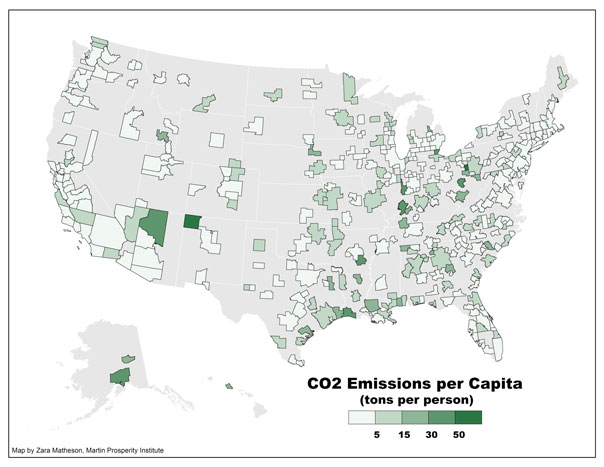
Three recent articles published by The Atlantic’s online site Cities: Place Matters provide differing perspectives on the future of greater Los Angeles. While the news is not all good, what’s clear is that some progress is being made to address the region’s looming environmental problems. Now, if only all the planning and good intentions can become a reality.
—-
In a piece titled Which Cities Tend to Be the Greenest? Richard Florida makes the case that Los Angeles, like some of the other largest metropolitan regions in the United States, is among the cleanest when it comes to carbon emissions. Take, for example, this finding related to CO2 emissions per capita.
Twelve large metros – including New York, (2.3 tons per person), L.A. (1.8 tons), San Diego (1.9 tons), Phoenix (1.9 tons), Washington, D.C. (2.3 tons), Miami (2.2 tons) and Seattle (2.2 tons) – rank among the 50 lowest emitting metros. It’s notable how well super-large metros (those with more than three million or even five million residents, like New York and L.A.) do on these rankings.
 Map produced by Zara Matheson of the Martin Prosperity Institute
Map produced by Zara Matheson of the Martin Prosperity Institute
While this finding is counterintuitive, it points to several key factors that make the largest metro regions greener than smaller communities. Florida puts it this way.
“We find that larger metropolitan areas are… relatively efficient regardless of their size, geography, age, and industrial composition. That’s because large metros share qualities like scale, density, and clustering of their populations and economic activities, which play a substantial role in reducing emissions and shaping their relative greenness.”
So the take away is this: cities and large metro regions [at least in the US] are not the gross polluters of our popular imagination. Instead, they play an important role in reducing greenhouse gases and emissions, as well as conserving energy.
—-
Christine MacDonald examines another environmental issue in her article titled, How Climate Change Could Be the Ruin of Los Angeles. What key resource does this piece focus on? If you guessed water, you’re right. This is Los Angeles after all.
In a nutshell, MacDonald posits that Los Angeles faces two very significant environmental threats, both of which stem from climate change. The first is rising sea levels and the second, reduced water supplies. She puts it this way.
“Few cities are facing the serious environmental double whammy that’s most likely in store for Los Angeles. Not only do scientists predict that rising sea levels will increase the likelihood of coastal flooding there, but also that rising temperatures will threaten the snow pack in the Sierra Nevada mountains, which provides about a third of the drinking water used by the L.A. Department of Water and Power, the nation’s largest municipal utility.”
MacDonald’s piece does highlight some of the things local governments are doing to address these challenges. For example, the LADWP is seeking ways to find more reliable local water supplies, as well as commissioning consultants to find innovative solutions to the water shortage problem.
Despite those efforts, however, MacDonald’s article makes the case that LA is way behind cities like New York, Chicago and Seattle when it comes to focusing on the impacts of climate change. Clearly more must be done soon to address these looming problems.
——
While local governments in southern California are not doing as much as they could and should do to address a wide range of environmental challenges, there is evidence that they are beginning to work more cooperatively together on a region wide basis. Take Kaid Benfield’s article titled Is SoCal America’s Next Environmental Success Story?
In that story, he writes about how the Southern California Association of Governments (SCAG), the nation’s largest metropolitan planning organization, is tackling pressing problems, such as traffic congestion and poor air quality, on a regional level by unanimously adopting a 25-year, Sustainable Communities Strategy. According to Associated Press reporter Andrew Dalton, that plan represents a significant shift in emphasis for the 191 member cities because it “…aims to make train tracks, bike lanes and clear skies as much a part of the region’s image as boulevards and freeways.”
Benfield summarizes some of the plan’s key objectives as follows:
- Invest $246 billion in public transportation
- Fund 12 major transit expansion projects in Los Angeles over the next 10 years, under LA Mayor Villaraigosa’s 30-10 plan
- Increase funding for bicycling and walking over threefold, from $1.8 to $6.7 billion
- Reduce traffic congestion 24 percent per capita despite the addition of four million residents
- Place 60 percent more housing in transit-accessible locations
- Create 4.2 million jobs in the region, and place 87 percent of all jobs within a half mile of transit service
- Reduce pollution-caused respiratory problems by 24 percent, resulting in $1.5 billion per year in health care savings
- Save over 400 square miles of farmland and other open space from development
While all of these goals are admirable and would generally garner widespread support across the region, many obstacles remain before even partial implementation is possible. Locking in adequate funding and sustaining the political will are just two of the challenges that lie ahead. That said, adoption of this plan is a step in the right direction and it’s promising that the region’s local governments have come together to adopt a land use, transportation and economic development roadmap that can lead to a healthier environment for residents and visitors alike.


Follow Us!